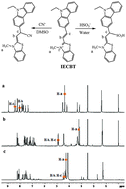A single fluorescent probe for multiple analyte sensing: efficient and selective detection of CN−, HSO3− and extremely alkaline pH†
Abstract
A simple tailor-made water-soluble broadly emitting (500–650 nm) fluorescent probe 3-methyl-2-(N-ethylcarbazole-3vinyl)-benzothiazolium iodide (IECBT) for the selective and sensitive detection of multiple analytes, including CN−, HSO3− and extremely alkaline pH, is designed and synthesized via the ethylene bridging of 3-formyl-N-ethylcarbazole and 2,3-dimethyl benzothizolium iodide, which is a useful fluorescent probe for monitoring these analytes at extremely low concentrations quantitatively. CN− and HSO3− are expected to undergo 1,4-addition reactions with the C-4 atom in the ethylene group of IECBT. This water-soluble fluorescent probe exhibits excellent sensitivity and selectivity toward CN− in DMSO, which also results in a prominent fluorescence ratiometric change and a color change. The high selectivity and sensitivity of IECBT toward HSO3− and extremely alkaline pH over other coexisting species in water are also observed. The titration experiments show that it features a remarkably large Stokes shift and good stability towards CN−, HSO3− or extremely alkaline pH with a significant fluorescence turn-off response. Importantly, we demonstrate that IECBT can be used for the real-time sensing and bioimaging of CN−, HSO3− or extremely alkaline pH in living samples.

- This article is part of the themed collection: JMC B Editor’s choice web collection: ‘‘seeing the unseen updated: advances in biosensing’’

 Please wait while we load your content...
Please wait while we load your content...